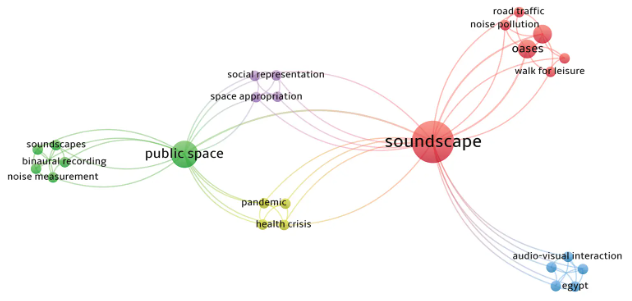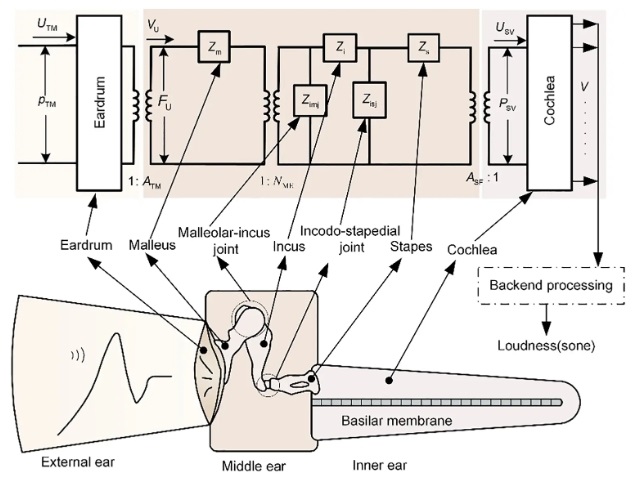Sound insulation prediction and optimization of wooden support structure for high-speed train floor based on machine learning
Abstract
In order to improve the sound insulation performance of high-speed train floors, this study first obtained the necessary data for model training based on the reverberation test method, and then conducted data sorting and feature selection. Next, the maximum mutual information minimum redundancy (mRMR) feature selection algorithm was used to calculate the selected features and screen out a subset of significant features. Subsequently, the decision tree, BP neural network, and support vector machine regression (SVR) methods were applied in sequence, and the standardized feature data were used for the high-speed train floor under the same evaluation criteria of the mean square error (MSE) and coefficient of determination (R2). We conducted training and validation of the sound insulation prediction models for timber-framed support structures. The prediction accuracy of the trained model was compared and evaluated with the finite element statistical energy analysis (FE-SEA) prediction model. Finally, the SVR model was used to optimize the design under constraint conditions. The research results show that based on the research object, sample library, and model training in this article, compared with the FE-SEA model, the prediction error of the SVR model is only 0.3 dB, showing better performance. In engineering practice, the SVR model can effectively optimize the wooden support structure in the floor under certain constraints, and it predicts that the weighted sound insulation of the entire floor is 50.45 dB, which has important engineering application value.
References
[1]Jin, X. (2018). Key problems faced in high-speed train operation. China’s High-Speed Rail Technology: An International Perspective, 27-45. https://doi.org/10.1007/978-981-10-5610-9_2.
[2]Park, B., Jeon, J. Y., Choi, S., Park, J. (2015). Short-term noise annoyance assessment in passenger compartments of high-speed trains under sudden variation. Applied Acoustics, 97, 46-53. https://doi.org/10.1016/j.apacoust.2015.04.007.
[3]Zhang, J., Han, G., Xiao, X., Wang, R., Zhao, Y., Jin, X. (2018). Influence of wheel polygonal wear on interior noise of high-speed trains. China’s High-Speed Rail Technology: An International Perspective, 373-401. https://doi.org/10.1631/jzus.A1400233.
[4]Liu, C., Ma, K., Zhu, T., Ding, H., Sun, M., Wu, P. (2024). A New Car-Body Structure Design for High-Speed EMUs Based on the Topology Optimization Method. Applied Sciences, 14(3), 1074. https://doi.org/10.3390/app14031074.
[5]Thompson, D., Kouroussis, G., Ntotsios, E. (2019). Modelling, simulation and evaluation of ground vibration caused by rail vehicles. Vehicle System Dynamics, 57(7), 936-983.https://doi.org/10.1080/00423114.2019.1602274.
[6]Hardy, A. (1999). Railway passengers and noise. Proceedings of the Institution of Mechanical Engineers, Part F: Journal of Rail and Rapid Transit, 213(3), 173-180. https://doi.org/10.1243/0954409991531128.
[7]Thompson, D., Jones, C. (2000). A review of the modelling of wheel/rail noise generation. Journal of sound and vibration, 231(3), 519-536. https://doi.org/10.1006/jsvi.1999.2542.
[8]Noh, H. (2017). Contribution analysis of interior noise and floor vibration in high-speed trains by operational transfer path analysis. Advances in Mechanical Engineering, 9(8), 1687814017714986. https://doi.org/10.1177/1687814017714986.
[9]Hu, Y., Nakao, T., Nakai, T., Gu, J., Wang, F. (2005). Vibrational properties of wood plastic plywood. Journal of Wood Science, 51, 13-17. https://doi.org/10.1007/s10086-003-0624-9.
[10]Jiang, S., Yang, S., Zhang, B., Wen, B. (2019). Experimental and numerical investigation on the external aerodynamic noise of high-speed train. Sound & Vibration, 53(4), 129-138. https://doi.org/10.32604/sv.2019.04048.
[11]Shi, J., Zhang, J. (2024). Effect of bogie cavity end wall inclination on flow field and aerodynamic noise in the bogie region of high-speed trains. Computer Modeling in Engineering & Sciences, 139(2), 2175-2195. https://doi.org/10.32604/cmes.2023.043539.
[12]Sadri, M., Brunskog, J., Younesian, D. (2016). Application of a Bayesian algorithm for the Statistical Energy model updating of a railway coach. Applied Acoustics, 112, 84-107.https://doi.org/10.1016/j.apacoust.2016.05.014.
[13]Han, Y., Sun, W., Zhou, J., Gong, D. (2019). Vibration Analysis of Composite Multilayer Floor of High‐Speed Train. Shock and Vibration, 2019(1), 6276915. https://doi.org/10.1155/2019/6276915.
[14]Kim, S., Seo, T., Kim, J., Song, D. (2011). Sound-insulation design of aluminum extruded panel in next-generation high-speed train. Transactions of the Korean Society of Mechanical Engineers A, 35(5), 567-574. https://doi.org/10.3795/KSME-A.2011.35.5.567.
[15]Wang, R., Yao, D., Zhang, J., Xiao, X., Jin, X. (2023). Effect of the laying order of core layer materials on the sound-insulation performance of high-speed train carbody. Materials, 16(10), 3862. https://doi.org/10.3390/ma16103862.
[16]Zhang, J., Yao, D., Wang, R., Xiao, X. (2021). Vibro-acoustic modelling of high-speed train composite floor and contribution analysis of its constituent materials. Composite Structures, 256, 113049. https://doi.org/10.1016/j.compstruct.2020.113049.
[17]Yao, D., Zhang, J., Wang, R., Xiao, X. (2021). Vibroacoustic damping optimisation of high-speed train floor panels in low-and mid-frequency range. Applied Acoustics, 174: 107788. https://doi.org/10.1016/j.apacoust.2020.107788.
[18]Maknickas, A., Ardatov, O., Bogdevičius, M., & Kačianauskas, R. (2022). Modelling the interaction between a laterally deflected car tyre and a road surface. Applied Sciences, 12(22), 11332. https://doi.org/10.3390/app122211332.
[19]Liu, J., Yu, M., Chen, D., Yang, Z. (2022). Study on interior aerodynamic noise characteristics of the high-speed maglev train in the low vacuum tube. Applied Sciences, 12(22), 11444. https://doi.org/10.3390/app122211444.
[20]Peng, C., Cheng, S., Sun, M., Ren, C., Song, J. et al. (2024). Prediction of sound transmission loss of vehicle floor system based on 1d-convolutional neural networks. Sound & Vibration, 58(1), 25-46. https://doi.org/10.32604/sv.2024.046940.
[21]Panahi, E., Hosseinkhani, A., Frangi, A., Younesian, D., Zega, V. (2022). A novel low-frequency multi-bandgaps metaplate: Genetic algorithm based optimization and experimental validation. Mechanical Systems and Signal Processing, 181, 109495. https://doi.org/10.1016/j.ymssp.2022.109495.
[22]Wu, L., Zhai, Z., Zhao, X., Tian, X., Li, D., Wang, Q., et al. (2022). Modular design for acoustic metamaterials: low‐frequency noise attenuation. Advanced Functional Materials, 32(13), 2105712. https://doi.org/10.1002/adfm.202105712.
[23]Li, Z., Ma, T., Wang, Y., Chai, Y., Zhang, C., Li, F. (2022). Active auto-adaptive metamaterial plates for flexural wave control. International Journal of Solids and Structures, 254, 111865.https://doi.org/10.1016/j.ijsolstr.2022.111865.
[24]Liu, Z., Xu, H., Zhu, P. (2020). An adaptive multi-fidelity approach for design optimization of mesostructure-structure systems. Structural and Multidisciplinary Optimization, 62(1), 375-386.https://doi.org/10.1007/s00158-020-02501-x.
[25]Zhang, J., Xiao, X., Sheng, X., Zhang, C., Wang, R., Jin, X. (2016). SEA and contribution analysis for interior noise of a high speed train. Applied Acoustics, 112, 158-170. https://doi.org/10.1016/j.apacoust.2016.05.019.
[26]Xie, G., Thompson, D., Jones, C. (2006). A modelling approach for the vibroacoustic behaviour of aluminium extrusions used in railway vehicles. Journal of Sound and Vibration, 293(3-5), 921-932. https://doi.org/10.1016/j.jsv.2005.12.015.
[27]Cotoni, V., Langley, R., Shorter, P. (2008). A statistical energy analysis subsystem formulation using finite element and periodic structure theory. Journal of sound and Vibration, 318(4-5), 1077-1108.https://doi.org/10.1016/j.jsv.2008.04.058.
[28]Kim, K., Lee, J., Kim, D. (2012). A study on the vibroacoustic analysis of aluminum extrusion structures. Comput Aided Des Appl PACE, 2, 1-8. https://doi.org/10.3722/CADAPS.2012.PACE.1-8.
[29]Yu, Y., Xiao, X., Wang, D., Wang, H. (2011). Prediction of interior structure borne noise of a cabin of high speed train using FE-SEA hybrid methods. In INTER-NOISE and NOISE-CON Congress and Conference Proceedings (Vol. 2011, No. 4, pp. 3073-3078). Institute of Noise Control Engineering.
[30]Yan, G., Li, Y., Huang, X., Yao, S., Zhou, W. (2023). Multi-objective optimization of elastic metaplates for lightweight and ultrawide bandgaps. International Journal of Mechanical Sciences, 259, 108603. https://doi.org/10.1016/j.ijmecsci.2023.108603.
[31]Li, M. (2018). A study on the influence of non-intelligence factors on college students’ English learning achievement based on C4. 5 algorithm of decision tree. Wireless Personal Communications, 102(2), 1213-1222. https://doi.org/10.1007/s11277-017-5177-0.
[32]Doksoo, L.; Chen, W.; Wang, L.-W.; Chan, Y.-C. Data-Driven Design for Metamaterials and Multiscale Systems: A Review. Adv. Mater. 2024, 36, 2305254. https://doi.org/10.1002/adma.202305254.
[33]Zheng, X., Zhang, X., Chen, T., Watanabe, I. (2023). Deep learning in mechanical metamaterials: from prediction and generation to inverse design. Advanced Materials, 35(45), 2302530. https://doi.org/10.1002/adma.202302530.
[34]Carleo, G., Troyer, M. (2017). Solving the quantum many-body problem with artificial neural networks. Science, 355(6325), 602-606. https://doi.org/10.1126/science.aag2302.
[35]Wang, R., Yao, D., Zhang, J., Xiao, X., Xu, Z. (2023). Identification of Key Factors Influencing Sound Insulation Performance of High-Speed Train Composite Floor Based on Machine Learning. Acoustics.6,1-17. https://doi.org/10.3390/acoustics6010001.
[36]Sahib, M., Kovács, G. (2023). Elaboration of a multi-objective optimization method for high-speed train floors using composite sandwich structures. Applied Sciences, 13(6), 3876.https://doi.org/10.3390/app13063876.
[37]ISO (2021). ISO 10140-2:2021; Acoustics—Laboratory Measurement of Sound Insulation of Building Elements—Part 2: Measurement of Airborne Sound Insulation. ISO: Geneva, Switzerland.
[38]ISO (2013). ISO 717–1:2013; Acoustics—Rating of Sound Insulation in Buildings and of Building Elements—Part 1: Airborne Sound Insulation. ISO: Geneva, Switzerland.
[39]Peng, H., Long, F., Ding, C. (2005). Feature selection based on mutual information criteria of max-dependency, max-relevance, and min-redundancy. IEEE Transactions on pattern analysis and machine intelligence, 27(8), 1226-1238. https://doi.org/10.1109/TPAMI.2005.159.
Copyright (c) 2024 Haiyang Ding, Ruiqian Wang, Xuefei Zhang, Ziyan Xu, Ancong Zhang, Lei Xu

This work is licensed under a Creative Commons Attribution 4.0 International License.









